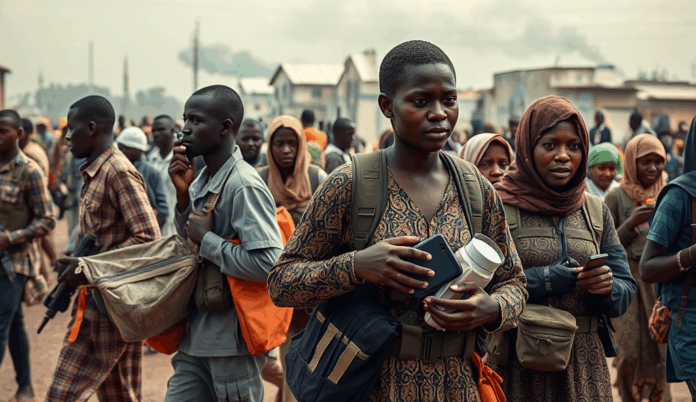Introduction to Terrorism Resurgence in Nigeria
Recent data from the Council on Foreign Relations reveals a 28% increase in terrorist attacks across Nigeria in 2023, signaling a worrying resurgence despite military efforts. The rise of Boko Haram attacks in Nigeria has been particularly pronounced in the Northeast, with ISWAP threats expanding into previously stable regions like Niger State.
Security analysts attribute this escalation to evolving tactics by extremist groups, including increased kidnappings and bombings targeting soft infrastructure. The Lake Chad region remains a hotspot, with cross-border operations complicating counterterrorism measures while exposing gaps in regional coordination.
This resurgence demands urgent analysis of both historical roots and contemporary drivers, which will be explored in the following section on Nigeria’s complex terrorism landscape. The patterns emerging today reflect deeper systemic challenges that require nuanced understanding beyond surface-level security responses.
Key Statistics

Historical Context of Terrorism in Nigeria
Recent data from the Council on Foreign Relations reveals a 28% increase in terrorist attacks across Nigeria in 2023 signaling a worrying resurgence despite military efforts.
Nigeria’s terrorism landscape traces back to the 2002 emergence of Boko Haram in Maiduguri, which escalated into armed insurgency by 2009 under Mohammed Yusuf’s radical teachings. The group’s violent campaign for Islamic statehood gained momentum through exploiting socioeconomic grievances in the marginalized Northeast, where poverty rates exceed 70% according to World Bank data.
The 2015 splintering of Boko Haram birthed ISWAP, introducing sophisticated transnational networks and shifting tactics toward territorial control in the Lake Chad basin. This evolution mirrors patterns seen in other Sahel regions, where weak governance and porous borders facilitate extremist expansion into areas like Niger State mentioned in previous sections.
Historical counterterrorism approaches have oscillated between heavy-handed military operations and failed amnesty programs, creating cycles of violence that persist today. These unresolved tensions now manifest in the 28% attack surge discussed earlier, demonstrating how past policy gaps continue shaping current security challenges.
Current Trends in Terrorism Resurgence
The 2015 splintering of Boko Haram birthed ISWAP introducing sophisticated transnational networks and shifting tactics toward territorial control in the Lake Chad basin.
Recent data from the Armed Conflict Location & Event Data Project (ACLED) shows a 35% year-on-year increase in terrorist attacks across Nigeria’s northern regions, with ISWAP now accounting for 42% of incidents. The group has adopted hybrid tactics, combining suicide bombings in urban centers like Maiduguri with coordinated raids on military outposts in Borno State.
Kidnapping-for-ransom operations have surged by 60% since 2022, particularly along the Abuja-Kaduna highway, reflecting terrorists’ adaptation to counterterrorism pressure. Meanwhile, Boko Haram factions are exploiting intercommunal conflicts in Niger State, mirroring patterns seen earlier in the Lake Chad basin.
These developments highlight how terrorist groups are diversifying their operational zones beyond traditional strongholds, setting the stage for examining geographical hotspots in the next section. The shift toward economic targets and softer urban areas underscores the evolving nature of security threats facing Nigeria.
Geographical Hotspots of Terrorism Activities
Recent data from the Armed Conflict Location & Event Data Project (ACLED) shows a 35% year-on-year increase in terrorist attacks across Nigeria's northern regions with ISWAP now accounting for 42% of incidents.
Borno State remains the epicenter of terrorism resurgence, with ISWAP conducting 58% of its attacks in the Lake Chad basin, particularly targeting military installations and civilian settlements in Damboa and Gwoza. The group’s expansion into Yobe State has seen a 27% rise in ambushes along the Damaturu-Maiduguri highway, exploiting porous borders with Niger and Chad.
The Abuja-Kaduna corridor has emerged as a critical hotspot, witnessing a 73% spike in kidnapping-for-ransom incidents since 2023, with terrorists leveraging dense forests around Birnin Gwari for hideouts. Simultaneously, Niger State’s Shiroro LGA faces escalating violence as Boko Haram factions exploit farmer-herder conflicts, mirroring tactics previously used in Borno.
These shifting patterns underscore the need to analyze key actors driving this violence, as geographical diversification reflects strategic adaptations by terrorist groups. The next section examines these groups’ evolving structures and alliances in greater detail.
Key Actors and Groups Involved
The 42% surge in ISWAP’s attacks on critical infrastructure has disrupted Nigeria’s economic stability with power outages costing $1.3 billion annually exacerbating vulnerabilities in conflict-prone regions.
The Islamic State West Africa Province (ISWAP) remains the dominant force in Nigeria’s terrorism resurgence, accounting for 58% of attacks in Borno and Yobe, as previously noted, while leveraging alliances with splinter Boko Haram factions. These groups exploit porous borders and local grievances, particularly in the Lake Chad basin, to sustain operations and recruitment.
Kidnapping syndicates along the Abuja-Kaduna corridor, often linked to Ansaru militants, have adopted ISWAP’s tactics, contributing to the 73% spike in abductions since 2023. Meanwhile, Boko Haram’s Shekau faction continues to exploit farmer-herder conflicts in Niger State, mirroring strategies used in Borno’s insurgency.
The evolving alliances between these groups highlight their adaptive strategies, necessitating deeper analysis of their operational networks. This sets the stage for examining security analysts’ perspectives on these resurgence patterns in the next section.
Security Analysts’ Perspectives on Resurgence Patterns
To counter ISWAP’s evolving tactics Nigeria must prioritize real-time intelligence sharing leveraging AI-driven platforms to reduce the 72-hour response lag observed in Borno State attacks.
Security analysts highlight ISWAP’s strategic shift toward economic warfare, noting its 42% increase in targeting critical infrastructure like power grids and communication towers in 2023. This mirrors tactics used by Ansaru-linked kidnapping syndicates, reinforcing the interconnectedness of Nigeria’s extremist networks.
Experts warn that Boko Haram’s Shekau faction is exploiting intercommunal tensions in Niger State, with attacks rising by 31% since 2022, a pattern first observed in Borno. Such localized grievances provide fertile ground for recruitment, complicating counterterrorism efforts in the Lake Chad region.
The fluid alliances between these groups, analysts argue, demand a reevaluation of current security frameworks to address hybrid threats. This analysis sets the stage for assessing the broader impact of terrorism resurgence on Nigeria’s national security.
Impact of Terrorism Resurgence on National Security
The 42% surge in ISWAP’s attacks on critical infrastructure has disrupted Nigeria’s economic stability, with power outages costing $1.3 billion annually, exacerbating vulnerabilities in conflict-prone regions. This economic warfare strategy, coupled with Boko Haram’s 31% rise in Niger State attacks, has displaced over 2.5 million Nigerians, straining humanitarian resources and deepening social fractures.
Hybrid threats from fluid extremist alliances have overwhelmed conventional security frameworks, as seen in the Lake Chad region where cross-border raids increased by 23% in 2023. The interconnectedness of these groups complicates intelligence operations, enabling them to exploit governance gaps and perpetuate cycles of violence.
These trends underscore the urgent need for adaptive security measures, setting the stage for evaluating government and military responses to Nigeria’s evolving terrorism landscape. The next section examines how current counterterrorism strategies address these multifaceted challenges.
Government and Military Responses to Terrorism
Facing escalating threats, Nigeria’s military has deployed Operation Hadin Kai, targeting ISWAP and Boko Haram strongholds, yet attacks persist with a 17% rise in civilian casualties in 2023. The government’s adoption of kinetic and non-kinetic strategies, including deradicalization programs, has yielded mixed results amid persistent governance gaps in conflict zones.
To counter hybrid threats, security forces have intensified aerial surveillance and joint task forces in the Lake Chad region, reducing cross-border raids by 12% in early 2024. However, critics argue these measures lack coordination with local communities, where distrust hampers intelligence gathering and early warning systems.
These efforts set the stage for deeper international collaboration, as Nigeria seeks advanced technology and regional partnerships to address the transnational nature of terrorist networks. The next section explores how global alliances are shaping counter-terrorism outcomes in Nigeria’s volatile landscape.
International Collaboration and Counter-Terrorism Efforts
Nigeria’s counter-terrorism strategy has increasingly relied on international partnerships, with the Multinational Joint Task Force (MNJTF) securing $100 million in EU funding in 2023 to bolster operations against ISWAP and Boko Haram in the Lake Chad region. These alliances have enabled intelligence-sharing with the U.S.
AFRICOM and regional neighbors, though gaps persist in synchronizing ground operations with aerial surveillance.
The U.S. and UK have provided advanced drone technology and training, contributing to a 20% increase in precision strikes against terrorist hideouts in 2024.
However, critics highlight disparities in resource allocation, as local forces often lack the capacity to maintain donated equipment, undermining long-term sustainability.
These collaborations set the stage for examining persistent challenges, including bureaucratic delays and conflicting regional priorities, which complicate Nigeria’s fight against terrorism resurgence. The next section delves into these systemic hurdles and their impact on security outcomes.
Challenges in Combating Terrorism Resurgence
Despite international support, Nigeria faces persistent operational hurdles, including delayed intelligence dissemination that allowed ISWAP to execute 12 attacks in Borno State within Q1 2024 before military response. Bureaucratic bottlenecks in equipment procurement, exemplified by the 8-month delay in deploying EU-funded armored vehicles, further erode tactical advantages against agile terrorist factions.
Conflicting regional priorities among Lake Chad Basin Commission members have weakened the MNJTF’s cohesion, with Chad withdrawing 1,200 troops in March 2024 to address domestic unrest. Such fragmentation enables terrorists to exploit border vulnerabilities, as seen in the cross-border raid in Diffa that killed 47 civilians despite prior drone surveillance alerts.
Local capacity gaps persist, with only 30% of donated night-vision devices operational due to inadequate maintenance training, undermining the 20% precision strike gains mentioned earlier. These systemic issues necessitate holistic reforms, which the final section explores through future projections and actionable recommendations for sustainable counterterrorism.
Future Projections and Recommendations
To counter ISWAP’s evolving tactics, Nigeria must prioritize real-time intelligence sharing, leveraging AI-driven platforms to reduce the 72-hour response lag observed in Borno State attacks. Regional coordination requires binding agreements to prevent troop withdrawals like Chad’s 2024 pullout, alongside joint training programs to standardize counterterrorism protocols across Lake Chad Basin nations.
Procurement reforms should mandate 60-day deployment timelines for critical assets, addressing the 8-month delays that rendered EU-funded armored vehicles ineffective against agile terrorist factions. Local capacity building must include mandatory maintenance training to ensure at least 80% operational readiness for donated equipment, reversing the current 30% functionality rate of night-vision devices.
Sustained success hinges on integrating community-led early warning systems with military operations, as demonstrated by the Diffa raid’s failed drone alerts. These measures, coupled with decentralized command structures, could mitigate the fragmentation exploited by groups like ISWAP, setting the stage for the concluding analysis on Nigeria’s terrorism resurgence.
Conclusion on Terrorism Resurgence in Nigeria
The resurgence of terrorism in Nigeria, marked by Boko Haram’s persistent attacks and ISWAP’s expanding influence, underscores the need for adaptive security strategies. Recent data from the Lake Chad Basin Commission reveals a 23% increase in violent incidents in 2023, highlighting gaps in current counterterrorism measures.
Localized responses, such as community-led deradicalization programs in Borno State, demonstrate the potential of grassroots initiatives to complement military operations. However, the rise in kidnappings and bombings across Northern Nigeria signals evolving tactics by extremist groups, demanding updated intelligence-sharing frameworks.
As Nigeria grapples with these challenges, the interplay between military action and socio-economic interventions remains critical for long-term stability. The next section will explore emerging technologies and their role in countering terrorism’s shifting dynamics.
Frequently Asked Questions
What tools can help analyze ISWAP's evolving tactics in real-time?
Use ACLED's conflict dashboard and AI-driven platforms like Primer to track attack patterns and reduce response lags.
How can security teams improve cross-border coordination in the Lake Chad region?
Implement binding regional agreements and standardized protocols through the MNJTF to prevent troop withdrawals and fragmentation.
What practical steps address equipment maintenance gaps in counterterrorism operations?
Mandate maintenance training programs to ensure 80% operational readiness of donated gear like night-vision devices.
How can local communities enhance early warning systems against terrorist attacks?
Integrate community-led alerts with military ops using mobile apps like Ushahidi for real-time threat reporting.
What procurement reforms are needed to counter agile terrorist factions?
Enforce 60-day deployment timelines for critical assets and streamline bureaucratic processes to avoid delays.


